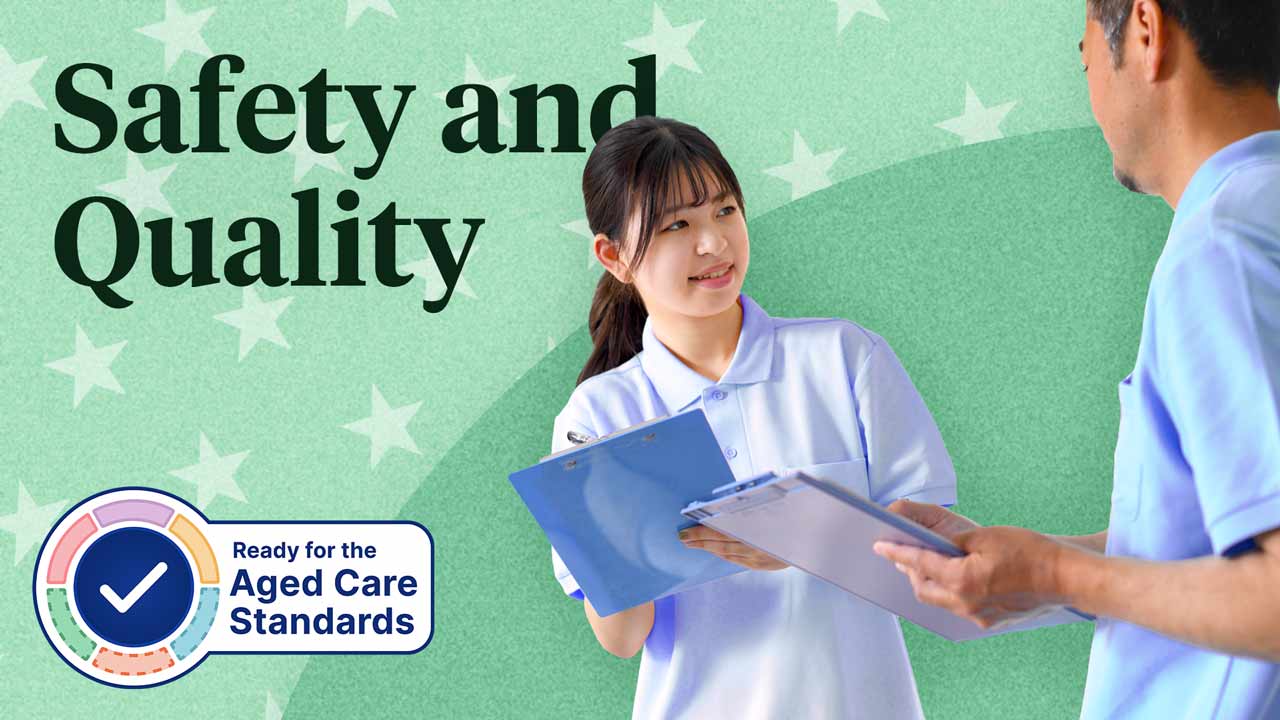Every staff member of a health service organisation is, in some way, responsible for ensuring that safe and high-quality care is delivered to clients.
The organisation’s role is to support its workforce to understand and perform their designated safety and quality roles and responsibilities (ACSQHC 2018).
What is ‘Safety and Quality’?
Safety is the practice of preventing errors and adverse outcomes in healthcare, while quality refers to the likelihood of positive client outcomes and how well the organisation works in tandem with current professional expertise (ACSQHC 2013).
STEEEP Framework for Safety and Quality
Safety and quality can be defined further using the STEEEP framework:
| Safe | Avoiding harm to patients and keeping staff safe. |
| Timely | Preventing delays that impede the flow of care. |
| Effective | Delivering evidence-based care only to those who are likely to benefit. |
| Equitable | Providing equal access to care regardless of gender, income, ethnicity, location etc. |
| Efficient | Using resources sustainably. |
| Patient-centred | Delivering respectful, responsive care that considers individual clients’ preferences, values and needs. |
(Adapted from West Moreton Health 2020)
Together, safety and quality practices aim to ensure that clients receive the right care, in the right place, at the right time and cost (ACSQHC 2018).

Safety and Quality Roles and Responsibilities in the National Safety and Quality Health Service Standards
Safety and quality roles and responsibilities are outlined in Actions 1.25 and 1.26 of the National Safety and Quality Health Service Standards, under Standard 1: Clinical Governance.
These actions aim to ensure that staff are supported and supervised to appropriately fulfil their designated safety and quality roles and responsibilities. Providers are required to:
- Assign safety and quality roles and responsibilities to staff
- Support their staff to understand and perform these roles and responsibilities
- Supervise staff to perform these roles and responsibilities safely.
(ACSQHC 2018, 2019)
Safety and Quality Roles and Responsibilities Under the Strengthened Aged Care Quality Standards
Standard 2: The Organisation - Outcome 2.2: Quality and safety culture (Action 2.2.2) of the strengthened Aged Care Quality Standards requires an aged care organisation’s governing body to prioritise the safety, health and wellbeing of older people and staff (ACQSC 2024).
The governing body is responsible for:
- Fostering a culture of safety, inclusion and quality
- Making improvements to the quality and safety culture and quality management system based on the views of older people in their care
- Providing role descriptions that state each person’s responsibility in fostering a positive quality and safety culture.
(ACQSC 2024)
Safety and Quality Roles
Safety roles and responsibilities within an organisation can be seen as a hierarchical structure wherein:
- A governing body oversees safety and quality practices.
- Managers operate the organisation within the parameters established by the governing body, ensuring that safety and quality systems perform effectively.
- Staff work within safety and quality systems. They are expected to adhere to professional codes of conduct and are held accountable for their practice.
- Clients receive care from staff.
(West Moreton Health 2020)
More specific roles and responsibilities should be outlined in the organisation’s policies and procedures, as well as in individual staff members’ position descriptions (West Moreton Health 2020).
Upholding Roles and Responsibilities
To ensure safety and quality roles and responsibilities are upheld effectively, organisations should:
- Ensure roles and responsibilities are clearly defined, delegated and documented
- Ensure roles and responsibilities are outlined in policies and procedures
- Regularly review whether staff are fulfilling their roles and responsibilities
- Train staff to fulfil their roles and responsibilities
- Identify professional development opportunities
- Review position descriptions when required
- Supervise junior staff.
(ACSQHC 2018)
Supervision

One key component of safety and quality is supervising junior staff to ensure they appropriately fulfil their roles and responsibilities. The aim is for junior staff to increase their competency and eventually become independent. Supervision should include regular performance feedback and reviews (ACSQHC 2019).
Those responsible for supervising junior staff should:
- Have the necessary skills, qualifications and training
- Have appropriate experience
- Be located in a place where they can supervise adequately
- Participate in the review process.
(ACSQHC 2019)
Conclusion
All clients expect and deserve safe and high-quality care. This responsibility falls upon every staff member, and the health service organisation is expected to ensure individual roles and responsibilities are clearly defined. Furthermore, the health service organisation must support staff to understand and appropriately uphold their designated roles and responsibilities.
Test Your Knowledge
Question 1 of 3
Finish the sentence. Safety is…
Topics
References
- Aged Care Quality and Safety Commission 2024, Standard 2: The Organisation, Australian Government, viewed 15 April 2024, https://www.health.gov.au/resources/publications/strengthened-aged-care-quality-standards-august-2025?language=en
- Australian Commission on Safety and Quality in Health Care 2013, About us, Australian Government, viewed 15 April 2024, https://www.safetyandquality.gov.au/about-us
- Australian Commission on Safety and Quality in Health Care 2018, Action 1.25: Safety and Quality Roles and Responsibilities, Australian Government, viewed 15 April 2024, https://www.safetyandquality.gov.au/standards/nsqhs-standards/clinical-governance-standard/clinical-performance-and-effectiveness/action-125
- Australian Commission on Safety and Quality in Health Care 2019, Action 1.26 Safety and Quality Roles and Responsibilities, Australian Government, viewed 15 April 2024, https://www.safetyandquality.gov.au/standards/nsqhs-standards/clinical-governance-standard/clinical-performance-and-effectiveness/action-126
- West Moreton Health 2020, Framework for Safety and Quality 2020, Queensland Government, viewed 15 April 2024, https://www.westmoreton.health.qld.gov.au/sites/default/files/inline-files/clinical-governance-framework.pdf
 New
New 
